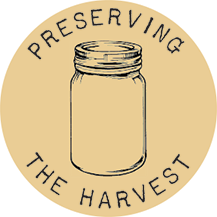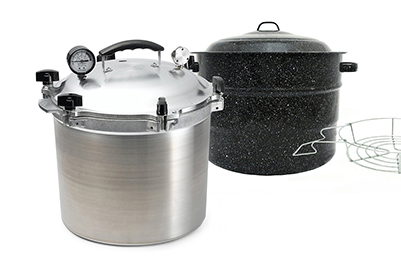by Judy Price and Diane Whitten


There’s nothing more rewarding than producing your own food for self-sufficiency and health. But a large garden can produce so much that, when the summer’s bounty is ready to be harvested, there can be more than one family can consume before it spoils. Food preservation is an essential skill that will help you enjoy your harvest throughout the year.
People choose to preserve their garden produce for various reasons. Some do not like to waste food. Others are concerned about the additives in commercially preserved foods, such as artificial colors or preservatives, and choose to preserve at home for health reasons. Still other home preservers find that they can save money by growing and storing food, even considering the cost of soil amendments and watering when necessary. Perhaps you wish to preserve for one or more of these reasons, or perhaps for the personal satisfaction of seeing a shelf filled with food jars lovingly prepared by you and your family. In any method of preserving, there are ways family members of all ages can contribute. Research shows that a child is more apt to eat food that he or she has helped to prepare. Even the youngest can snap beans or crush berries!

Canning, freezing and drying are the three main methods of preserving food. There are two safe ways of canning, depending on the type of food being canned. Acidic foods, such as tomatoes and fruit, can be preserved using the boiling water or the atmospheric steam canning method. Either of these types of canners are not very expensive and are a good way to get started preserving. Boiling water and steam canners may also be used to preserve pickled and jellied products.
Vegetables have a low acid level and must be canned using the pressure canning method. This canning method creates temperatures exceeding 2400 F., necessary to destroy the Clostridium botulinum spores that only grow in low acid foods. This is the bacteria that causes the food borne illness Botulism. There are two kinds of pressure canners, those with dials that are read as the canner’s internal temperature rises, and those that are regulated by a weight over the steam vent. Which type you choose to use depends partly on the elevation of your home and somewhat on your personality.
Freezing is the only method of food preservation that requires a continuous use of power. While the freezer section of a refrigerator/freezer appliance will allow you to store food for a fairly short period of time, if you want to store large amounts of frozen food, you may want to purchase an upright or a chest freezer. These dedicated appliances will allow you to keep food in excellent condition at 00 or even -100 F. Freezing is a quick and easy way to preserve fruits and vegetables. Knowing a few tips will assure that your frozen foods will be safe and of high quality. Something as simple as blanching vegetables an appropriate amount of time, or packaging food only in freezer quality materials, go a long way to having delicious, high quality food you have frozen yourself.
Drying, one of the oldest forms of food preservation, is a good option for long-term storage, also. Microorganisms require water to live and removing the natural water from foods is a simple way to preserve them. Unfortunately, the high humidity level in New York State requires that dehydration takes place in a dehydrator. Those living in the southwest can air dry or sun dry fruits and vegetables. If New Yorkers try this for any food other than herbs, the food will become moldy before it is dry!
Fermentation, an ancient form of food preservation, can extend the shelf life of produce four to six months, long enough to get you through the long winter months. In fermentation, lactic acid is formed, making the food more acidic so that spoilage microorganisms cannot grow. Fermented foods such as sauerkraut, kimchi, fermented pickles, and kombucha are known for their pro-biotic health benefits. If these foods are then canned, the probiotic advantages no longer exist, but they are still healthy
Cooperative Extension:
Best Bet for Home Food Preservation Instructions
Food preservation instructions change over the years as safer and more effective ways to preserve food are developed. Food preservation instructions are researched and updated by the USDA which then passes the latest information on to Cooperative Extension. Recent research has devised a safe way to can fish in quart canning jars. This research was done for USDA at the University of Alaska, where a need was seen for the indigenous people whose main sustenance is fish. The University of Wisconsin recently developed safe canning directions for using an atmospheric steam canner. This is a great advantage in areas of the country suffering from drought, as much less water is required than using a boiling water canner.
The University of Georgia Cooperative Extension is the direct link to the USDA through its National Center for Home Food Preservation, accessible online to everyone at uga.edu/nchfp.
There is a wealth of information at this site from basic food preservation how-tos, such as “How to Use a Canner,” to more than 185 specific recipes that are guaranteed to be safe. There are tutorials, PowerPoint presentations, and much more for the home canner. Since botulism food poisoning can occur in low acid canned foods, it’s vital that you use a safe, tested recipe to keep your family healthy. Recipes on this website and other sites ending in .edu can be trusted resources for research-based canning directions. Beware of canning directions found on social media, which may disseminate unsafe methods.
Cornell Cooperative Extension Resources
Of course, there is nothing like a hands-on or demonstration class to learn home food preservation techniques and build confidence in your skills. Some county extension offices may be offering evening or weekend food preservation classes. The Master Food Preserver Program is a three-day intensive classroom and hands-on learning experience, offered in various locations around New York State. So far this summer, five well-attended workshops have been held. These workshops include the science of preservation (why we must do what has been researched and recommended), and special units on high-acid canning, low-acid canning, jam and jelly making and preserving, quick pickles and fermented products, freezing, and dehydration. If you would like to join the more than 760 individuals who have taken this workshop since its inception in 2006, contact the Cornell Cooperative hosts listed below. These workshops are taught by the authors.
August 13–15 CCE Niagara County, Lockport, NY
host Amanda Henning, [email protected]
September 10-12 CCE Chautauqua County, Falconer, NY
host Emily Reynolds, [email protected]
September 17-19 CCE Essex County, Willsboro, NY
host Linda Gillilland, [email protected]
Judy Price and Diane Whitten are Cornell Cooperative Extension home food preservation experts.
Views: 3




